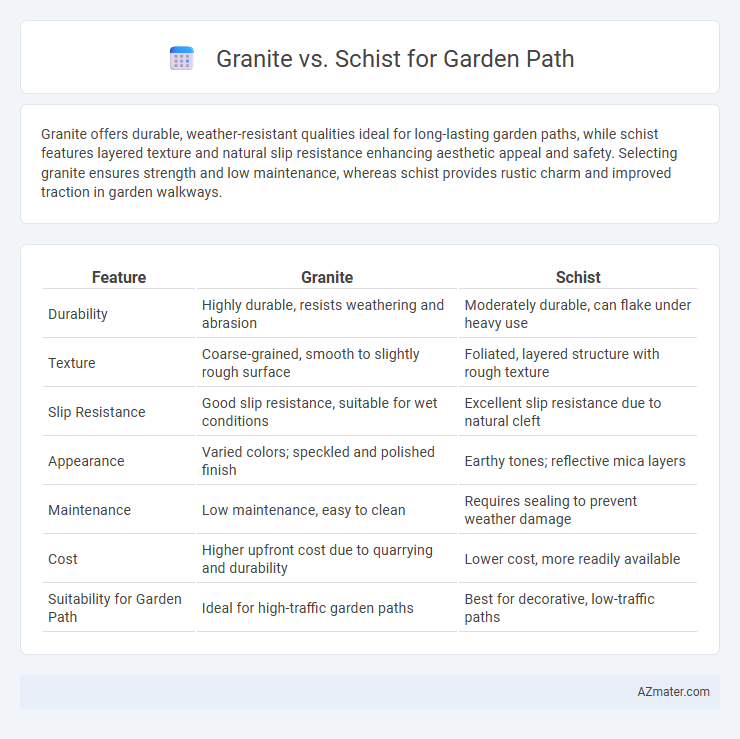Granite offers durable, weather-resistant qualities ideal for long-lasting garden paths, while schist features layered texture and natural slip resistance enhancing aesthetic appeal and safety. Selecting granite ensures strength and low maintenance, whereas schist provides rustic charm and improved traction in garden walkways.
Table of Comparison
| Feature | Granite | Schist |
|---|---|---|
| Durability | Highly durable, resists weathering and abrasion | Moderately durable, can flake under heavy use |
| Texture | Coarse-grained, smooth to slightly rough surface | Foliated, layered structure with rough texture |
| Slip Resistance | Good slip resistance, suitable for wet conditions | Excellent slip resistance due to natural cleft |
| Appearance | Varied colors; speckled and polished finish | Earthy tones; reflective mica layers |
| Maintenance | Low maintenance, easy to clean | Requires sealing to prevent weather damage |
| Cost | Higher upfront cost due to quarrying and durability | Lower cost, more readily available |
| Suitability for Garden Path | Ideal for high-traffic garden paths | Best for decorative, low-traffic paths |
Granite vs Schist Overview for Garden Paths
Granite offers exceptional durability and a coarse texture, making it ideal for garden paths that require long-lasting, slip-resistant surfaces. Schist, characterized by its foliated, layered structure, provides a natural, rustic appearance but may weather more quickly under foot traffic. Choosing between granite and schist depends on balancing the need for strength and maintenance with desired aesthetics in garden path design.
Aesthetic Differences: Visual Appeal in Garden Design
Granite offers a sleek, polished appearance with varied grain patterns and a wide color spectrum, enhancing modern or formal garden paths with a clean, durable surface. Schist features a layered, textured look with sparkling mica flakes that catch light, providing a rustic, natural charm ideal for informal or woodland garden designs. Choosing between granite and schist depends on whether the garden path aims for contemporary elegance or organic, earthy aesthetics.
Durability Comparison: Longevity in Outdoor Environments
Granite offers exceptional durability for garden paths due to its high resistance to weathering, scratches, and erosion, making it ideal for long-term outdoor use. Schist, while visually appealing with its layered texture, is more prone to flaking and weather-induced degradation, reducing its lifespan under harsh environmental conditions. Choosing granite ensures greater longevity and minimal maintenance in outdoor garden paths.
Slip Resistance: Safety Underfoot
Granite offers excellent slip resistance for garden paths due to its coarse-grained texture and natural durability, making it a safe option underfoot even when wet. Schist, while visually appealing with its foliated layers, can become slippery when polished or damp, posing a higher risk for slips. Choosing rough-finished or textured granite enhances safety and traction, essential for garden pathways exposed to moisture and foot traffic.
Maintenance Requirements for Granite and Schist Paths
Granite garden paths require minimal maintenance due to their durability and resistance to weathering, making them ideal for long-term use with occasional cleaning to remove dirt and debris. Schist paths demand more upkeep because their foliated structure tends to flake and erode over time, necessitating regular inspection and replacement of loose pieces to maintain a safe walking surface. Both materials benefit from periodic sealing to protect against moisture damage, but granite generally offers a more low-maintenance option for garden pathways.
Cost Analysis: Budgeting Your Garden Path Project
Granite offers a higher upfront cost, averaging $10 to $30 per square foot, but its durability ensures long-term savings with minimal maintenance for garden paths. Schist, priced between $5 and $15 per square foot, provides a more budget-friendly option but may require more frequent upkeep due to its softer composition. For a cost-effective garden path project, balancing initial investment with future maintenance expenses is essential when choosing between granite and schist.
Installation Ease: Working with Granite vs Schist
Granite offers greater ease of installation for garden paths due to its consistent hardness and ability to be cut into uniform shapes, reducing fitting time and effort. Schist's layered, foliated structure can cause irregular breakage, complicating precise placement and requiring more adjustments during installation. Choosing granite minimizes labor intensity and speeds up the process for durable, stable garden pathways.
Weather and Climate Suitability
Granite's durability and resistance to weathering make it ideal for garden paths in regions with heavy rainfall and freeze-thaw cycles, maintaining structural integrity over time. Schist, while aesthetically appealing with its layered texture, tends to be less weather-resistant, potentially flaking or eroding in humid or wet climates. For garden paths exposed to fluctuating temperatures and moisture, granite offers superior longevity and minimal maintenance compared to schist.
Environmental Impact and Sustainability
Granite, a durable igneous rock, has a significant environmental footprint due to energy-intensive quarrying and transportation processes. Schist, a metamorphic rock with a foliated texture, often requires less energy for extraction and processing, making it a more sustainable choice for garden paths. Both rocks are long-lasting, but sourcing local schist reduces carbon emissions and supports eco-friendly landscaping projects.
Choosing the Best Stone for Your Garden Path
Granite offers exceptional durability and resistance to weathering, making it an ideal choice for high-traffic garden paths requiring long-lasting strength. Schist provides a distinctive, layered texture with natural slip resistance but tends to be softer and more prone to erosion over time. Selecting the best stone depends on balancing aesthetic preferences with maintenance needs, where granite suits a more rugged, low-maintenance path and schist complements rustic, decorative garden designs.

Infographic: Granite vs Schist for Garden Path
 azmater.com
azmater.com